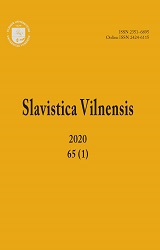Интернациональная лексика русского и словенского языков: категория рода
The International Vocabulary of Russian and Slovenian Languages: Gender Category
Author(s): Jelena Mihailovna KonickajaSubject(s): Gender Studies, Morphology, Lexis, Semantics, Comparative Linguistics, Eastern Slavic Languages, South Slavic Languages
Published by: Vilniaus Universiteto Leidykla
Keywords: internationalisms; morphological category of gender; Slovenian language; Russian language; borrowing; comparative studies of vocabulary;
Summary/Abstract: Slovenian and Russian substantive internationalisms of different grammatical gender are compared in the present article. Five groups of internationalisms have been distinguished on the basis of the formed glossary based on the dictionaries of the two languages which includes about 450 pairs of lexemes with different gender characteristics: 1) Slovenian feminine ~ Russian masculine; 2) Slovenian masculine ~ Russian feminine; 3) Slovenian masculine ~ Russian neuter; 4) Slovenian feminine ~ Russian neuter; animated nouns constitute a separate group. The significant difference is the small number of neuter gender internationalisms in Slovenian, while there are a great number of such internationalisms in Russian; as well as the predominance of feminine gender borrowings in Slovenian. The analysis has illustrated that the internationalisms gender in both languages is determined by a common set of factors (the influence of gender of the prototype word, features of the morphological category of gender in language, lexical and semantic characteristics), which have different importance in the two languages. The influence of the prototype word gender is mainly characteristic in Slovenian, while structural and paradigmatic factors play a much larger role in Russian. The differences in the donor languages are of great importance for understanding the gender distinction of internationalisms in Slovenian and Russian. The time factor is more evident in Russian, where there is a gradual increasing importance of a paradigmatic factor in the gender determination of a number of borrowings, whereas for Slovenian, where a number of borrowings-internationalisms were formed later, the time factor does not play a big role.
Journal: Slavistica Vilnensis
- Issue Year: 65/2020
- Issue No: 1
- Page Range: 72-86
- Page Count: 15
- Language: Russian

